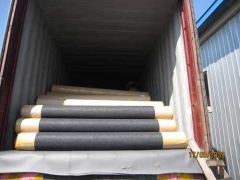Linoleum
| Infobox on Linoleum | |
|---|---|
| Example of Linoleum |  |
| Facts | |
| Origin | See text |
| Stowage factor (in m3/t) | 1,56 / 1,84 m3/t |
| Humidity / moisture | - |
| Ventilation | - |
| Risk factors | See text |
Linoleum
Description / Application
Linoleum is a floor covering made from renewable materials such as solidified linseed oil , pine rosin, ground cork dust, wood flour, and mineral fillers such as calcium carbonate, most commonly on a burlap or canvas backing; pigments are often added to the materials.
The finest linoleum floors, known as 'inlaid', are extremely durable; they were made by joining and inlaying solid pieces of linoleum. Cheaper patterned linoleums came in different grades or gauges, and were printed with thinner layers which were more prone to wear and tear. Good quality linoleum is sufficiently flexible to be used in buildings in which more rigid material (such as ceramic tile) would crack.
Linoleum as a floor covering has been largely replaced with polyvinyl chloride, which has similar properties of flexibility and durability, but which has greater brightness and translucency and which is relatively less flammable. The fire-retardant properties of PVC are due to chlorine-containing combustion products, some of which are highly toxic. Dioxins are released by burning PVC. While the polymer itself is generally considered safe, additives such as plasticizers and unintentional impurities such as free monomers are considered a hazard by some.
Because it is made of organic materials and is purportedly non-allergenic in nature, high quality linoleum is still in use in many places (especially in non-allergenic homes, hospitals and health care facilities). Linoleum tiles can be made to various designs and inlaid with various colours to form patterns reflecting the shape and use of a room.
The largest present day manufacturer of linoleum is Forbo Flooring which is based both in Assendelft (the Netherlands) and Kirkcaldy (Scotland), which sells the material under the trademarked name of Marmoleum. The company, which is part of the Switzerland-based Forbo Group, is the oldest manufacturer of linoleum in the world.
Shipment / Storage / Risk factors
Linoleum is usually shipped in rolls covered with paper with ends protected. Heavy pressure applied to bales of linoleum may result in internal damage without leaving external evidence of crushing. This happens because the inside laps, being rolled on a smaller radius, are naturally sharply curved and more quickly broken when that curve is further bent by crushing; the outside laps on the other hand will stand a fair amount of further bending before reaching breaking point.
Should not be overstowed with heavy goods.
If Rockfelt Base Linoleum is stowed in warm or heated areas, layers of rolls tend to adhere and rolls of printed patterns often adhere to the underside of the overlapping layer.
Cracking may be the result of linoleum being exposed to conditions of extreme cold. Low temperatures have the effect of freezing the oils in the linoleum and so cause cracking. Linoleum which has been subject to low temperatures should be removed to a warm place as soon as possible.











